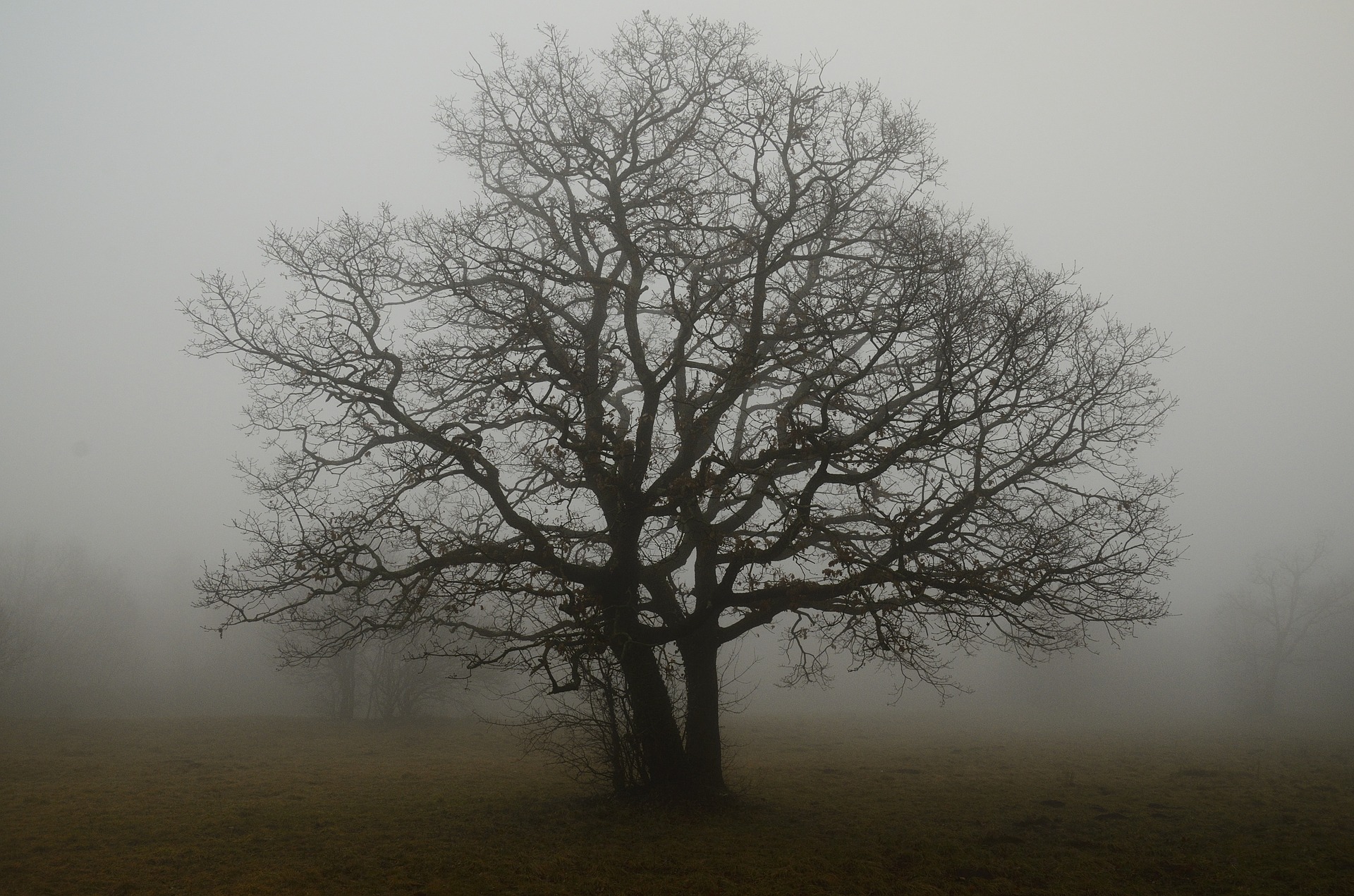 Submitted by Olivia on
Submitted by Olivia on

pixabay.com
Most of us are familiar with haunted objects and places but often we never consider that trees can be haunted as well.
New England is steeped in ghostly legends and folklore, with an unusually high number of haunted sites reported throughout the region: houses, bars or inns that played host to tragic events where tortured souls still reside; desolate roads or old cemeteries where lonely spirits walk the night; and whole areas where cursed villages were abandoned or great battles were fought, charged with the residual energy of the past. There are also haunted trees.
The belief in haunted trees goes back through history and across cultural boundaries. In the folk religion of the ancient Celts, trees were considered a link with the supernatural world. Tribal societies indigenous to the New England region, like the Abenaki and Wampanoag, had similar beliefs regarding tree-dwelling spirits and divinities. And the superstitious Puritans who settled here lived in constant fear of the dark forces that haunted the wooded areas just beyond their village walls...

THE HAUNTED ELM OF BARA-HACK
Pomfret, Connecticut
In the northeast corner of Connecticut, about an hour's drive from Hartford, is the town of Pomfret. At the outskirts of town, hidden in the woods near the Mashamoquet Brook, is the lost village of Bara-Hack. Little is known of the village’s actual history. Its founders are said to be two Welshmen: Obadiah Higginbotham, a deserter from the British navy during the American Revolution, and John Randall, who settled there sometime before 1780. Apparently, the Randall family owned slaves that worked their fields and local legend has it that it was among these slaves that the first reported hauntings were witnessed, sometime in the early 1800s. They claimed to have seen ghosts of the recently deceased and “strange gremlin-like creatures the size of small children” in the branches of the elm tree in the village cemetery.
Bara-Hack had been abandoned sometime after the Civil War. All that's left these days are some broken stone walls, old cellar holes... and the ghostly sounds of village life that can still be heard, earning it the nickname of “The Village of Voices”. Children laughing, men and women in conversation, dogs barking, and horse-drawn carriages rumbling over gravel paths have all been reported in the area.
In 1927, Odell Shepard, a professor at Harvard and Radcliffe College, went to Bara-Hack and wrote, "Although there is no human habitation for a long distance round about and no one goes there except the very few who go to listen, yet there is always a hum and stir of human life[...] It is as though sounds were able in this place to get round that incomprehensible corner, to pierce that mysterious soundproof wall that we call Time."
Most of this activity revolves around the old village burial grounds, and the haunted elm tree resides just outside of cemetery's north wall. Blue balls of light have been sighted in and around the tree, and most famously a spectral baby has been seen cradled in the branches looking out over the cemetery. The elm tree has since succumbed to the ravages of time and the elements, but the trunk still stands over the cemetery wall.
THE HANGED MEN OF WOLF'S ISLAND ROAD
Mattapoisett, Massachusetts
The Ellis-Bolles Cemetery is located on Wolf Island Road, a desolate stretch of mostly unpaved road that runs through the backwoods of Mattapoisett. Named after the Ellis and Bolles families who reside in a majority of the graves here, the cemetery is said to be an old Wampanoag burial site that was consecrated as a Christian burial ground in 1872. The area played a role during King Philip's War, with both sides of the conflict using the heavily wooded area to hide out and stage ambushes. Local legend has it that during one of these ambushes a large group of captured prisoners were executed and strung up from the trees around where the cemetery now resides (it’s not known which side was on the receiving end of the rope).
Over the years locals have reported sightings of spectral bodies hanging by their necks from the trees behind the stone wall at the back of the cemetery. Sometimes it’s a single body, but more often it’s a group of up to a half-dozen shadowy figures seen swinging from the branches. There are also reports of a phantom woodsman who lurks the surrounding area with an axe in hand, a glowing gravestone, and a woman in white who walks the cemetery grounds.
THE WHIPPING TREE
Harvard, Massachusetts
Towering over the Thaddeus Pollard House in Harvard, MA is “The Whipping Tree”. The majestic sycamore is nearly 100 feet tall and over 20 feet in circumference. It earned its name, not from being the site of official town punishment, but from an incident that occurred at the height of Shaker persecution in the area.
The Shakers, or Shaking Quakers, lived a tenuous existence in the community. In the summer of 1782 a riot broke out and the Shakers were forced to leave town, beaten and harassed along the way. A Shaker named Abijah Worster attempted to intervene in the assault of one of his brethren and was seized upon, stripped, tied to the sycamore tree and whipped for the crime of “going about breaking up churches and families.”
Worster survived, but each of the men who took part in the ordeal died in a relatively brief period after. Locals came to believe that the spot was cursed and the tree was haunted.
Not unlike the beliefs held by the later Spiritualists of the mid-19th century, spirits and the spirit world were an integral part of the original Shaker teachings. Mother Ann, the founder of the religious movement, had many ghostly visions and described them to her attentive followers. She would address the spirits in unknown tongues and channel their voices through self-possession. This supposed ability to communicate with the supernatural world was one of the reasons the Shakers were so feared by their neighbors. It’s easy to understand why The Whipping Tree was believed to be haunted.
THE DEVIL'S TREE
Brighton, Vermont
The small village of Island Pond can be found in the town of Brighton, located in the heart of Vermont's Northeast Kingdom. Although no one can seem to accurately date its origin, the dark tale of 'The Devil Tree' has been shared here for generations. The infamous tree, if it did indeed exist, was a large ancient oak that stood in the front yard of an old Victorian house. At some point in its history the tree had been split down the middle by a bolt of lightning, leaving it a mangled hulking mass. However, it was not by appearance alone that the tree earned its ominous name. It was also allegedly the site of a number of local tragedies – including a massacre of native tribesmen, and later, the hanging suicide of a former property owner.
As the story goes, the property where the giant tree stood was bought by a Boston businessman who used it as a summer retreat. For the remainder of the year the house and surrounding grounds were maintained by a caretaker named Jack Nolan. Local residents claimed that Nolan was a man of low character and peculiar beliefs. It was even rumored that held “satanic ceremonies” on the grounds in the owner's absence. One summer, when the owner returned to his property, it was discovered that the house had been ransacked of all its valuables and that the caretaker was nowhere to be found.
In the weeks that followed neighbors began to hear a strange moaning that seemed to come from The Devil Tree. When the owner finally had the tree removed from the property he made a grisly discovery. The decomposed remains of Jack Nolan, still clutching his bag of stolen valuables, was found in a hollow deep inside the tree. The popular explanation was that Nolan had previously made a pact with the Devil, and, on the night of the burglary, the Devil came to collect – body and soul.
SAGAMORE CEMETERY'S RESTLESS SPIRITS
Bourne, Massachusetts
Sagamore Cemetery is a small, quiet graveyard located in Bourne, MA. The earliest burials took place in 1803, and most of the gravestones date back to the 19th century. When construction for the Cape Cod Canal began in 1909, family plots from the nearby Bournedale Cemetery were relocated here. Unfortunately there was some confusion when the disinterred remains were being moved and a number of bodies were buried under the wrong headstones. Even members of the original Bourne family were among the displaced.
Whether or not it has anything to do with the marker mix-up, the entire cemetery is said to be haunted. Some people have reported a “sudden and severe sensation of cold” grip them when walking around. Others have claimed to have filmed strange images of bright orbs or shadowy figures. There is the ghost of a tall man in a top hat who disappears when approached, and another of a child bride in muddy boots. Also, caretakers have discovered headstones weighing several hundred pounds lifted and moved to other areas of the cemetery without so much as a footstep left behind.
Near the main entrance is an old, gnarled tree. From the right angle, a section of the knobby and bulbous trunk eerily resembles a man trying to break free from the inside. People claim to smell “an incredibly distinct aroma of cigar smoke” in the area around the tree. Its thought that its haunted by the ghost of Emory Ellis, a big cigar-smoking man who lived in the early part of the 20th century. Ellis's family had a plot that was among those moved to make way for the canal, though he protested fiercely with shovel and shotgun in hand. Eventually he was offered money and backed down, but some believe his angry spirit continues to protest from beyond the grave.
THE LISTENING TREE
Mackworth Island, Maine
Just off the coast of Falmouth, ME is Mackworth Island – home to the infamous Governor Baxter School for the Deaf, where rampant sexual and physical abuse of children took place for a period of over twenty years in isolation from the mainland.
The Listening Tree was an old white pine that was located on the school grounds. The tree had ‘faces’ that stuck out of the bark and appeared to be “upturned in agony with their mouths open”. It's believed that these were carved by native tribes, but their meaning or purpose remains unknown. Local legend claims that deaf children from the Baxter School could hear the tree talking to them, which is where the name comes from.
The Listening Tree was struck by lightning a few years back and has since been removed.
Additionally there is a nearby haunted pet cemetery where phantom dogs and horses have been seen roaming around and then disappear. Supposedly Stephen King visited here and was inspired to write his book “Pet Cemetery”.
HOOKMAN'S GHOST
Seymour, Connecticut
The Great Hill Cemetery is old, dating back to 1783, and reportedly home to all sorts of strange and ghostly phenomena. Known as “Hookman's Cemetery,” the graveyard is located in a wooded area just outside of New Haven. People report shadow figures walking the grounds at night. Paranormal investigators claim to have filmed “ectoplasmic mist” and other strange phenomenon on the cemetery grounds. Even the famous Connecticut "demonologist" couple, Ed and Lorraine Warren, have said that they believe there is an evil presence found here.
Local folklore (going back to at least the 1950s) has it that a former cemetery caretaker named Hookman committed suicide after being falsely accused of some crime, hanging himself from a large tree in the old section of the cemetery. Another version has it that the caretaker actually had a hook for a hand and murdered a local boy he caught trespassing at night. The boy's body was found the following morning impaled on the hook, which was left hanging from the tree, and the caretaker was never heard from again. Regardless of which story you go by, people claim that cars stall out when they pass under the tree or else the sound of boots can be heard dragging across the roof. A ghostly apparition has also been seen hanging from the branches.
Another legend involves an old house that used to be located behind the cemetery. Supposedly the family that lived there was murdered by the youngest son, who then killed himself, and their ghostly figures have been seen walking in cemetery at night.
THE WITCH TREE
Smithfield, Rhode Island
The Witch Tree was located in the middle of the intersection of Log Road and Mann School Road in Smithfield, RI. Due to the location of the tree it has caused quite a few fatal car accidents over the years.
Some say that if you drive around the Witch Tree three times and take off in a certain direction you will be followed by a phantom biker who died in a crash at the site. Others say that they have witnessed young children playing by the tree who suddenly seem to disappear.
Over the years the tree has started to rot away but still somehow would bloom in the spring. It stood up until a couple years ago when the town decided to cut it down for safety reasons.
THE TELL-TALE APPLE TREE
Franklin, Connecticut
The town of Franklin was once famous for a peculiar variety of apple with a sinister history. Micah Rood Apples – also known as “Bloody-Heart Apples,” or simply “Mike's” – were known for its cherry-red skin, snowy white interior, sweet flavor and a “bloody” red globule at the center. According to local legend, a traveling salesman from Philadelphia named Hank Karner came to the farm of Micah Rood to peddle his wares one fateful day in 1693. The man's battered and bloodied corpse was found the following day under a large apple tree in Rood's orchard, robbed of both money and merchandise. Suspicion immediately fell on the farmer. However, the townspeople could find no proof of guilt and he was never charged with the crime.
As the months passed and the fall harvest came around a curious thing happened. The blossoms of the apple tree under which Karner's body was found were crimson instead of their usual white color. Even more strange, the apples that it produced had what appeared to be a drop of blood near the core. It was widely believed that this was the result of a curse enacted from beyond the grave that pointed to Micah Rood's guilt. He would die under mysterious circumstances soon after.
Micah Rood's “tell-tale apple tree” was reportedly destroyed by a hurricane in 1938, but a version of the apple variety grafted from the original continues to be produced by other area orchards.
THE TREE OF KNOWLEDGE
Duxbury, Massachusetts
Duxbury is located on the coast of Cape Cod Bay, about 30 miles south of Boston. According to local folklore, the residents have lived under the threat of a curse for over two-hundred years now.
At the heart of this curse was a massive oak tree, which resided on the old Bay Path (now Rt. 53). The tree was an important landmark, serving as the first rural “post office” in America in the 1620's. Mail runners going between Massachusetts Bay Colony and Plymouth would leave packages or messages in a postal box at its base, to be collected by passing Duxbury citizens who would deliver them to their intended recipients. Because of this vital communication role, the old oak became known as “The Tree of Knowledge”.
Eventually the mail system modernized and the tree fell into disuse and was largely neglected. At some point in the early 19th century a massive storm struck the coast. When people came out of their shelters the following day they had discovered that the Tree of Knowledge had not survived the storm. It had been splintered by a bolt of lightning.
Soon after this, one of the elderly patriarchs from the community told the townspeople of a disturbing visitation he had experienced. The spirit of the old oak tree had come to him in a dream and was angry at the townspeople for failing to properly honor the role that the tree had played in the town's history and success. The grim specter declared that if the spot where the oak once stood was not properly memorialized it would be cursed.
A sign was immediately made to honor the Tree of Knowledge. To this day the site – located at Tree of Knowledge Corner, at the Summer and South Street intersection -- is still marked accordingly, and thus far the curse has been avoided.
SOURCES
- Passing Strange: True Tales of New England Hauntings and Horror, Joseph Citro
- Connecticut Ghost Stories and Legends, Thomas D'Agostino & Arlene Nicholson
- Haunted Cemeteries of New England: Stories, Stones and Superstitions, Roxie Zwicker
- Cursed in New England: Stories of Damned Yankees, Joseph Citro
- Ghosts of the Bridgewater Triangle, Christopher Balzano
- Weird Massachusetts: Your Guide to Massachusetts's Local Legends and Best Kept Secrets, Jeff Belanger
- Haunted Vermont: Ghosts and Strange Phenomena of the Green Mountain State, Charles Stansfield
- Ghosts of the Southcoast, Tim Wisberg
- Curious New England: The Unconventional Traveler's Guide to Eccentric Destinations, Joseph Citro & Diane Foulds
http://illuminating-shadows.blogspot.com/2013/04/haunted-trees-of-new-england.html
- 1914 reads